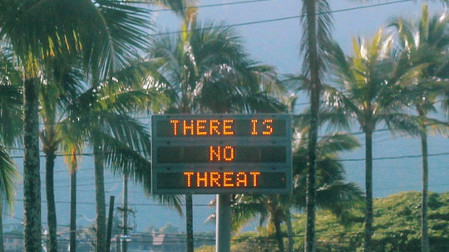HONOLULU—Scott Humber, news director of Hawaii News Now—the combined news operation of Raycom Media’s KHNL and KGMB in Honolulu—was upstairs in his bedroom at 8:07 a.m. last Saturday (Jan. 13) when he heard the alarm on his phone go off downstairs.

Scott Humber
“My wife came upstairs immediately and she was crying,” says Humber. “I took a second to calm her down, looked down at my phone and saw the alert.”
“BALLISTIC MISSILE THREAT INBOUND TO HAWAII. SEEK IMMEDIATE SHELTER. THIS IS NOT A DRILL.”
While his first reaction was disbelief because he didn’t hear civil defense sirens, Humber tuned his TV to his station and saw the EAS alert. What ensued for Humber and many broadcasters across the islands revealed not simply the vulnerability of the Emergency Alert System to human error upstream of their stations, but other threats to effective emergency communications to the public, such as the need for dependable two-way communications channels among critical station personnel as well as between stations and civil defense managers in the event of an emergency.
GET THE WORD OUT
Shortly after the warning went out, Humber received a call from one of his on-air talent saying that the alert was a false alarm. A neighbor who works for Hawaii Civil Defense ran to the talent’s house to say the alarm was in error.
The professional video industry's #1 source for news, trends and product and tech information. Sign up below.
A split second later, Humber’s assignment manager called to say the Honolulu Police Department, which got word the alarm was false three minutes after it was issued, was saying it wasn’t real, he says. With a second source confirming the error, Humber called his digital team and told them to get word out immediately on the station’s app that the alarm was false.
Humber’s luck with the phone ran out, however, when it came to alerting the station’s master control operators of the false alarm.
“Our first thought was we needed to get a crawl up on the air, but we couldn’t get through to our master control,” he says. Giving up on a voice call, Humber ultimately reached master control via text to instruct the MC operators to air an all-clear, which went on air by 8:30 a.m., he says.
At about that time, Humber made it into the station as did many of the station’s reporters and anchors who interrupted NCAA basketball on KGMB and a Premier League soccer game on KHNL with wall-to-wall coverage of the story for about four hours.
‘WORKED AS INTENDED’
If there is a silver lining to this false alarm event, it is that the EAS system’s over-the-air and IPAWS delivery succeeded in delivering the emergency alert as designed. “I would say the initial alert worked as intended,” says Chris Leonard, president of the Hawaii Association of Broadcasters and president and GM of New West Broadcasting, which operates five radio stations on the Big Island of Hawaii.
“It hit the air chain for our five radio stations. It hit the air chain for wireless devices for the wireless alert, and a crawl showed up on television stations as well.”
Participating EAS broadcasters don’t have a lot of flexibility in those first moments of a warning, he says.
“You have to take the alert at face value. It came through a verifiable source—in this case Hawaii Emergency Management—and our instruction to listeners was to proceed as advised. Shelter in place and heed the warning,” he says.

At 8:24 a.m., however, Leonard received a call from the mayor of Hilo at New West’s main studio that the message was a false alarm, which was followed one minute later by a recorded message from the emergency operating center to take to the air chain to announce the all-clear, he says.
By about 8:24 or 8:25 a.m., the broadcaster was on air alerting the public that the alarm was false. New West also pushed the all-clear to social media, he says.
‘A SHORT FUSE EVENT’
Where the system broke down was the failure of the state’s emergency management staff to use EAS to convey that the original warning was false until about 8:45 a.m., he says.
“I think the concern with that [using the EAS system to push the all-clear], although I don’t agree, is that typically we don’t receive an alert for something that is not happening. You don’t receive an alert that a flash flood warning is over,” says Leonard.
However, EAS does support issuing a message to inform the public of a false alarm by using an administrative code, he says. [The EAS system relies on predefined codes to trigger specific types of warnings, such as a hurricane or a tsunami.]
Courtney Harrington, chair of the state emergency communications committee in Hawaii, says that even if a specific EAS code to retract a warning does not exist, that is no excuse for not improvising by using the system’s other resources to inform broadcasters of a warning sent in error.
“If there is no code for withdraw, then send the message out under civil emergency,” he says. “There’s all kinds of codes that will trigger people. Who cares? Pick one. Implement. Thank you.”
Harrington, who is appointed by the FCC as the leader of the committee which oversees how Hawaii’s broadcasters use EAS, says a big part of the problem with the missile alert was that it was a “short fuse” event. In other words, from the time the alert was issued to expected impact of a missile is about 15 to 20 minutes versus the 72 hours that’s typical between the time a hurricane warning is issued and it arrives, he says.
With such a short fuse, there’s little time for the media and state emergency managers to communicate. Compounding the problem, are phone lines jammed with “everybody calling to see if their aunty is OK,” he says.
Regardless, the EAS system isn’t designed to be second guessed, he says. “One of the biggest questions I get from broadcasters is, ‘If this happens again, how do we confirm it?’ And my response is you can’t, and you shouldn’t,” says Harrington.
“This whole system, regardless of where you are in the country, is based upon trust. When an official on the government side activates the system, you must be confident there is a legitimate reason to do that.”
New West Broadcasting’s Leonard echoes that sentiment. “From a broadcaster’s perspective, when we receive an alert, it’s already been vetted and authenticated, and it’s not subject to our interpretation. We are required to forward that to our air chain and ultimately to our listeners,” says Leonard.
Phil Kurz is a contributing editor to TV Tech. He has written about TV and video technology for more than 30 years and served as editor of three leading industry magazines. He earned a Bachelor of Journalism and a Master’s Degree in Journalism from the University of Missouri-Columbia School of Journalism.

